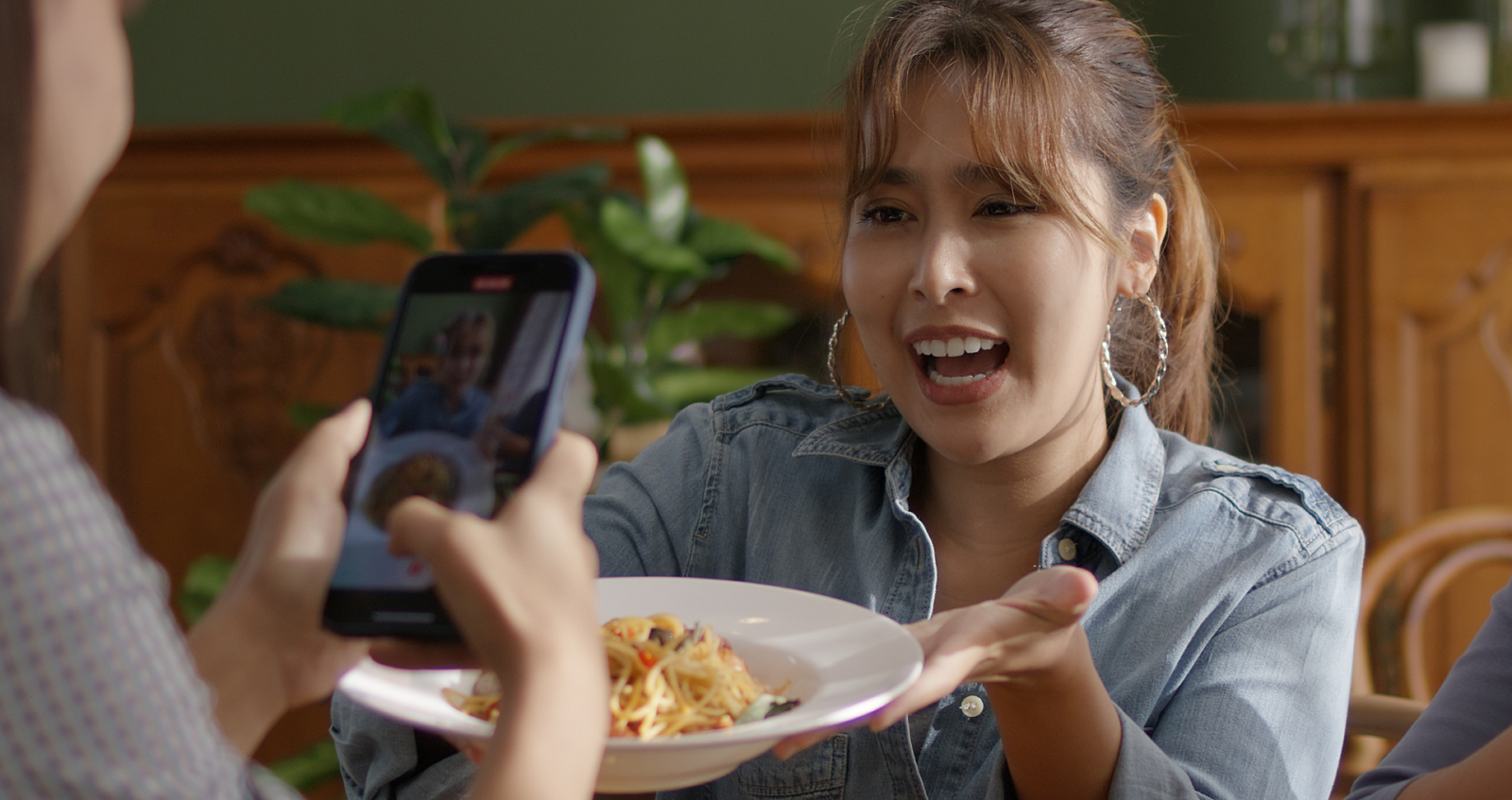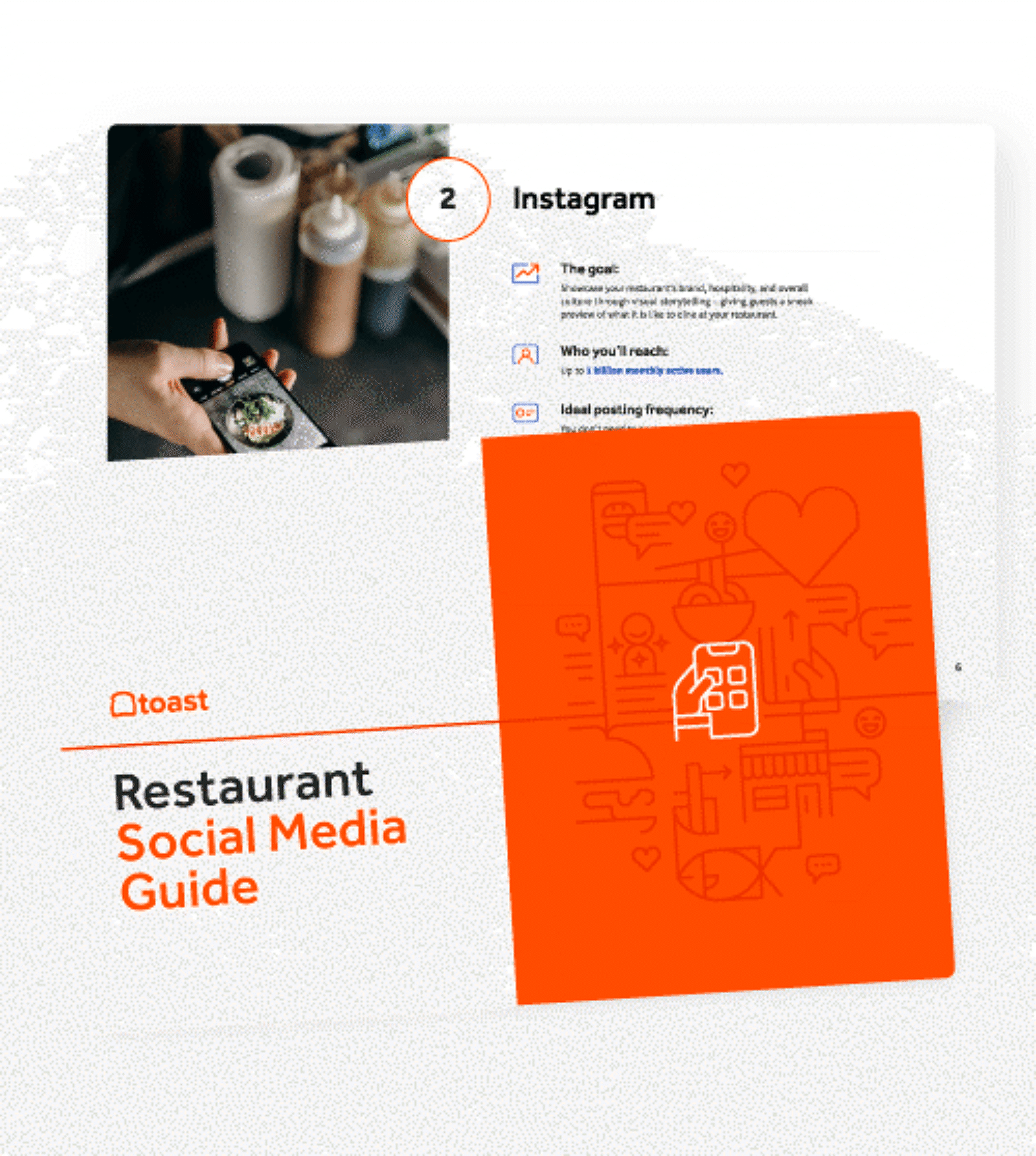
How Are Diners Using Social Media? 59% Of Respondents Use Facebook the Most To Discover New Restaurants
Toast conducted a blind survey on adults who are active on social media. Here’s the data we found regarding diners' social media preferences.

Tessa ZuluagaAuthor


Guide to Restaurant Social Media Marketing
Learn how to optimize your social media presence to showcase your brand, tell your story, attract new customers, and engage with your audience.
Get free downloadWhat was once an industry made up of word-of-mouth recommendations and professional critics has now transformed into a competition of visual content. Restaurants’ social media posts have become as essential as menus, while food influencers have gained the power to make or break an establishment overnight.
The art of food presentation on social media has skyrocketed, as 82% of restaurants in the United States use social media as part of their marketing strategies. Social media not only changed how we choose where to eat but has also reshaped the entire food industry as a whole.
To better understand how diners perceive restaurant social media nowadays, Toast conducted a blind survey of 850 guests who use social media at least once a week. Join us as we explore how these insights impact both diners and restaurateurs in 2024.
Quick insights:
59% of respondents use Facebook the most to discover new restaurants
42% of respondents prefer social media to search engines (Google, Yelp, etc.) when trying to discover new restaurants
84% of respondents prefer to see photos of food and drinks served on a restaurant's social media page
62% of respondents sometimes check a restaurant's social media before deciding to dine there
40% of respondents base their decision to dine at a restaurant on an influencer's review
43% of respondents think it's very important for restaurants to respond to comments or messages on social media
31% of respondents follow a restaurant on social media when they've been there and liked it
50% of respondents follow more restaurant accounts on social media vs. only 22% follow more influencers
Restaurant Marketing Plan
Create a marketing plan that'll drive repeat business with this customizable marketing playbook template and interactive calendar.

Social media marketing for restaurants: The most current insights
Your guests are on social media, so you should be, too. Let’s dive into where they’re looking, what content they enjoy, and more.
Where are guests discovering new restaurants?
The social media platform you should focus on depends on your target audience. We asked guests where they’re looking to discover new restaurants, and here’s what we found.
Approximately 59% of respondents use Facebook the most to discover new restaurants. Facebook, on average, attracts an older crowd. For example, 80% of guests over the age of 54 use Facebook. As age decreases so does interest:
62% of guests ages 35 to 44 use Facebook to discover new restaurants
70% of guests ages 45 to 54 use Facebook to discover new restaurants
45% of guests ages 25 to 34 use Facebook to discover new restaurants
Surprisingly, Instagram isn't the top choice for any age group. Only 19% of respondents use Instagram the most to discover new restaurants. However, younger diners tend to use the app more often compared to older generations. Roughly 40% of guests younger than 18 use Instagram the most to discover new restaurants. As age increases the use of the app decreases:
27% of guests ages 18 to 24 use Instagram to discover new restaurants
27% of guests ages 25 to 34 use Instagram to discover new restaurants
20% of guests between the ages of 35-44 use Instagram to discover new restaurants
14% of guests ages 45-54 use Instagram to discover new restaurants
9% of guests ages 54+ use Instagram to discover new restaurants
Although only 17% of guests overall use TikTok the most to discover new restaurants, diners ages 18 to 24 are most influenced by this specific app. Approximately 60% of guests younger than 18 use TikTok the most to discover new restaurants, meanwhile:
41% of 18-24 year-old use TikTok the most to discover new restaurants
23% of 25-34 year olds use TikTok the most to discover new restaurants
13% of 35-44 year olds use TikTok the most to discover new restaurants
13% of 45-54 year olds use TikTok the most to discover new restaurants
7% of guests ages 54+ use TikTok the most to discover new restaurants
Facebook might have a strong social media presence for new restaurant discovery, but guests still prefer a search engine. When asked which source guests use more often to discover new restaurants, 58% said search engines (Google, Yelp, etc). Older people have the highest usage of search engines for discovery, with 69% of guests ages 54+ choosing search engines.
In contrast, 42% of respondents said social media. Younger people are much more reliant on social for discovery: approximately 50% of guests ages 25-34 prefer social media to find new restaurants, and 48% of 18-24 year olds agreed. Women are also more likely to discover restaurants on social media than males (45% vs 38%).
Why does all of this data matter?
Restaurant brands can use this information to update their social media channels and online presence to target their preferred demographic. For example, younger women are likely to look at social platforms more often to discover a restaurant, and older men are more likely to use a search engine. If you’re looking to market to younger people, focus on your social media strategy. If you’re looking to attract older folks, consider implementing SEO best practices, monitoring online reviews, and investing in digital marketing.
What type of social media posts influence guests to dine at a restaurant?
To find out what restaurants can post to attract new customers, we asked respondents how often they check restaurant social media accounts and what kind of content they find to be the most influential. Here’s what we found.
100% of respondents from our survey check social media at least once a week. We then asked these social media users how often they check a restaurant's social media before deciding to dine there. 62% of respondents sometimes check a restaurant’s social media before deciding to dine there, 28% always check, and only 10% never check.
When we asked respondents what type of content on a restaurant's social media is most likely to influence their decision to visit, they responded with:
57% are influenced by pictures of the food
30% are influenced by creators giving positive reviews
10% are influenced by the ambiance
4% are influenced by pictures of the drinks
To make sure you’re posting high-quality pictures of your menu items, check out this article: 10 Food Photography Tips & Tricks for Restaurants.
What do guests prefer to see on social media?
Restaurants face a sea of options when it comes to social media content. To cut through the noise, we went straight to the source: diners themselves. We surveyed food enthusiasts about their preferences for restaurant social media profiles. Here’s what they said and how you can apply each learning:
84% prefer to see photos of food and drinks served at the restaurant - Restaurant owners and operators should focus on showcasing their signature dishes, seasonal specials, and popular menu items. Consider hiring a professional food photographer or investing in photography training for staff. You can also experiment with different styles: close-ups, overhead shots, and action shots (steam rising, sauce being poured, drinks being shaken) to see what works best.
47% prefer to see photos of the restaurant decor and ambiance - Capture the overall atmosphere, including lighting, seating arrangements, and unique design elements. Highlight outdoor spaces, private dining areas, or special features like a bar or open kitchen. You want guests to see what your atmosphere has to offer.
44% prefer to see promotions - Share information about happy hour specials, seasonal offers, or loyalty programs. This is also an opportunity to promote events such as live music nights, themed dinners, or cooking classes. Use eye-catching graphics or short videos to announce limited-time offers or new menu items.
38% prefer to see videos of the dining experience - Create short clips showcasing the restaurant's ambiance, including background noise and movement. You can even film brief table-side presentations or the preparation of signature cocktails. This is a great opportunity to try out new platforms like Instagram Reels.
19% prefer to see behind-the-scenes footage - Share glimpses of kitchen preparations, staff training, or the sourcing of ingredients. You can introduce key team members, such as the head chef or long-time servers. Consider showing the restaurant's involvement in community events or charitable initiatives.
Social media management includes responding to comments, DMs, and questions. Here’s how important respondents think it is for restaurants to respond to comments and messages on their social media:
43% think restaurants responding to comments on social media is very important
48% think restaurants responding to comments on social media is somewhat important
9% think restaurants responding to comments on social media is not important at all
For help on how to respond to comments while still staying professional and in your brand voice, check out this article: How to Respond to Common Restaurant Complaints on Social Media.
There are many different metrics to measure what “success” looks like on social media. However, according to Sprout Social, “follower growth tells a more complete story about your channel’s health, the awareness you’re building and whether you’re outpacing competitors—or falling behind.”
We asked participants what influences them the most to follow a restaurant on social media — here’s what we found:
31% follow when they’ve been to the restaurant and liked it - This highlights the importance of providing excellent service and food quality in-house. Providing a great customer experience is a marketing tool in itself.
30% follow when they want to know about their promotions and happenings - Keep posting your weekly events and line-ups. People want to know what special events you have to offer and they’re checking your socials to do so.
24% follow when they like the content the restaurant is sharing - This emphasizes the importance of creating high-quality content. If you can create engaging content, potential customers are likely to follow you and eventually try your restaurant.
18% follow when it’s a new restaurant they want to try - If you’re looking to grow your customer base, post on social media. A follow on your Instagram account this week might lead to new guests next week.
How do guests feel about restaurant influencers?
Recently, influencers have become a major part of many restaurant’s social media strategies. We asked participants if an influencer’s review of a restaurant, either positive or negative, impacted their decision to dine at that restaurant. Here’s what we found:
40% of guests base their decision on an influencer's review
38% say they would not be influenced
22% don’t follow influencers or don’t have an opinion
Influencer power is the strongest with the younger generations: 44% of respondents ages 18-24 answered that they can be influenced, and 49% of respondents ages 25-34 said the same. Males are also more likely to be influenced compared to women (43% vs. 38%).
Restaurants can leverage this power of influencers by developing strategic partnerships to attract new customers. They can invite local influencers, or micro-influencers, to sample new menu items or experience the restaurant's ambiance firsthand. Collaborating on content creation can provide engaging material for both the influencer's audience and the restaurant's social media channels.
Restaurants can also consider offering influencers unique discount codes to share with their followers, allowing for better tracking of the partnership's impact on foot traffic and sales. However, it's crucial for restaurants to carefully select influencers whose values and audience align with their brand, ensuring a genuine and effective collaboration.
These deals will likely attract a younger audience. We asked participants who they follow more on social media: restaurants or food influencers. They responded that:
50% follow more restaurants
22% follow more food influencers
28% follow neither
This also varies by age: 42% of respondents ages 54+ follow more restaurants, while 60% of respondents ages 16-70 follow more influencers.
Hashtag Hungry
Next time you see someone at a restaurant taking 50 photos of their plate before eating, don't judge – they might just be deciding where 40% of us eat next week.
Remember, it’s important to be on the right platforms for your specific restaurant business. If you’re targeting an older crowd, influencer marketing might not be your best option. But Facebook Ads and neighborhood groups might be a better place to start. For the younger folk, foodie influencers and TikTok just might be key.
Don’t forget that Toast can help you market your business with our well-rounded Marketing Suite. This includes:
Email marketing
Loyalty
Gift cards
Toast Tables
Click here to learn more.
Methodology
Toast conducted a blind survey on this topic of 850 U.S. citizens ages 16 and older on July 15, 2024. Respondents were not made aware that Toast was fielding the study. Using a standard margin of error calculation, at a confidence interval of 95%, the margin of error on average is +/- 3-5%.
Is this article helpful?
DISCLAIMER: This information is provided for general informational purposes only, and publication does not constitute an endorsement. Toast does not warrant the accuracy or completeness of any information, text, graphics, links, or other items contained within this content. Toast does not guarantee you will achieve any specific results if you follow any advice herein. It may be advisable for you to consult with a professional such as a lawyer, accountant, or business advisor for advice specific to your situation.
Subscribe to On the Line
Sign up to get industry intel, advice, tools, and honest takes from real people tackling their restaurants’ greatest challenges.
